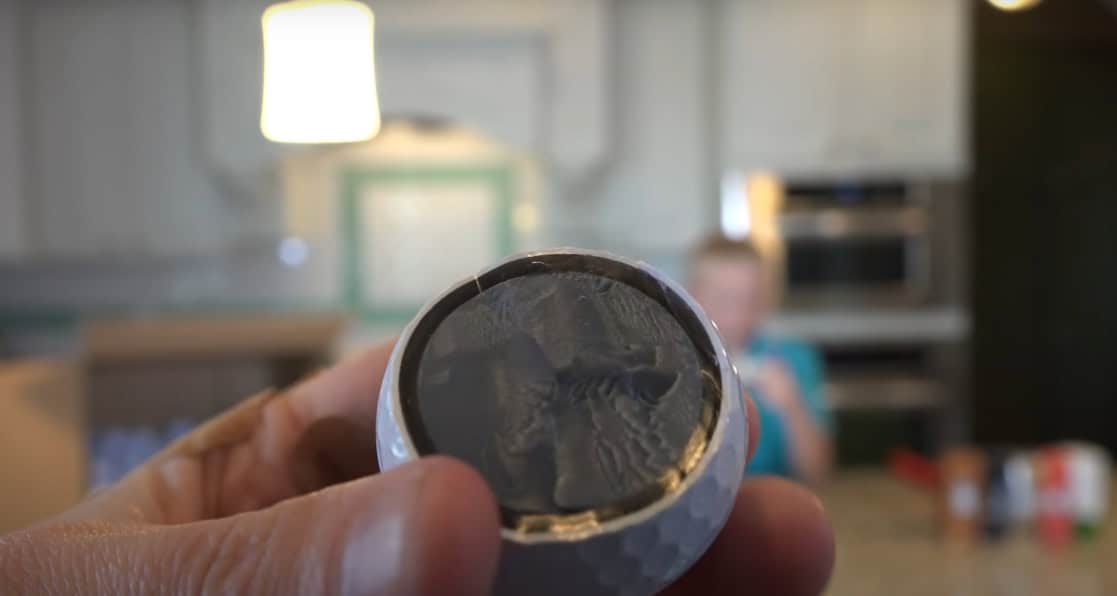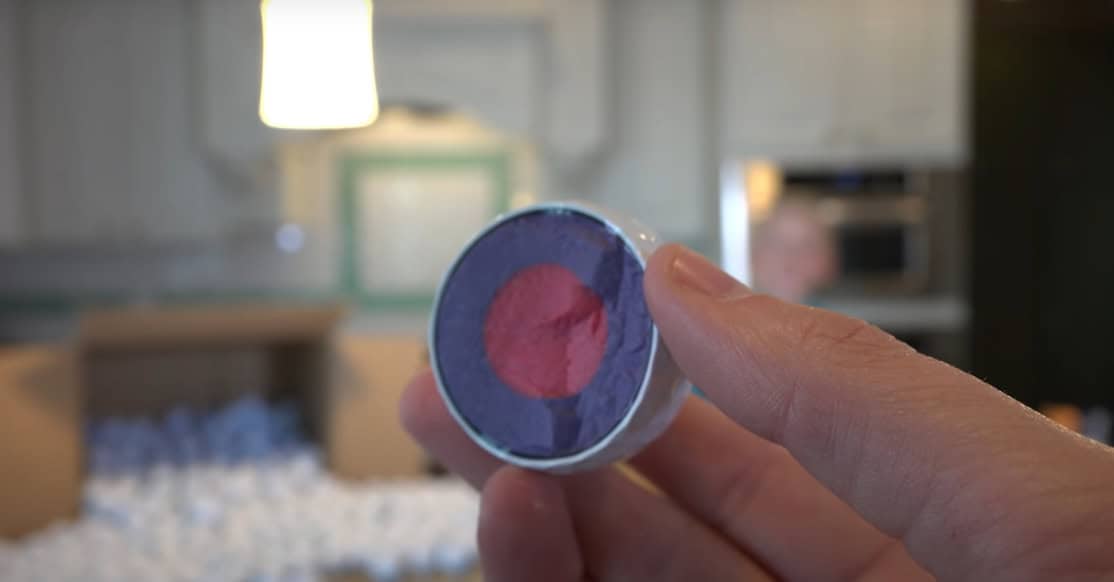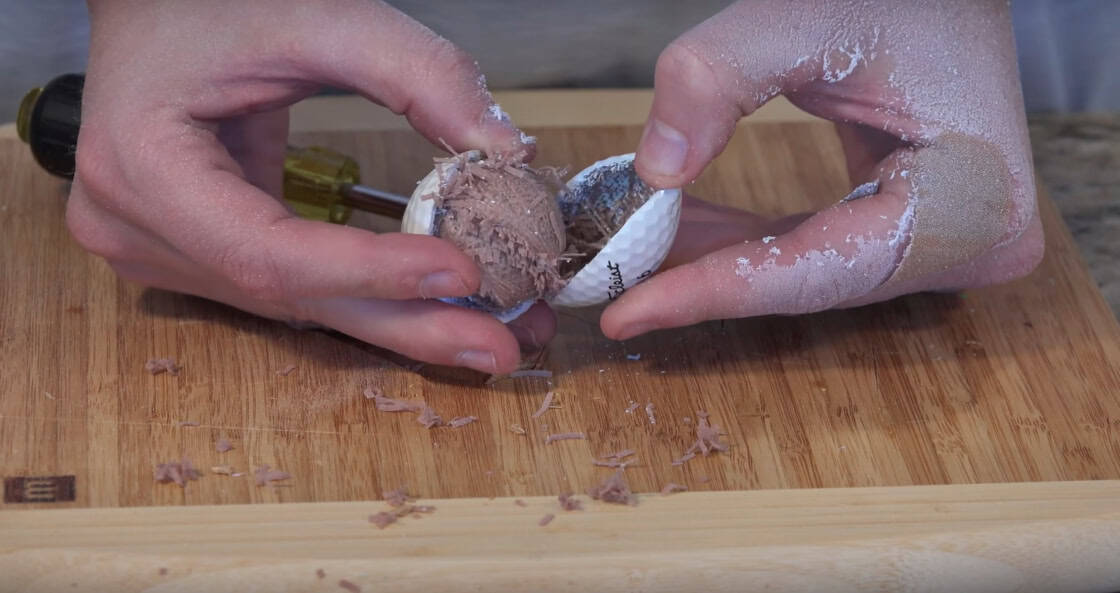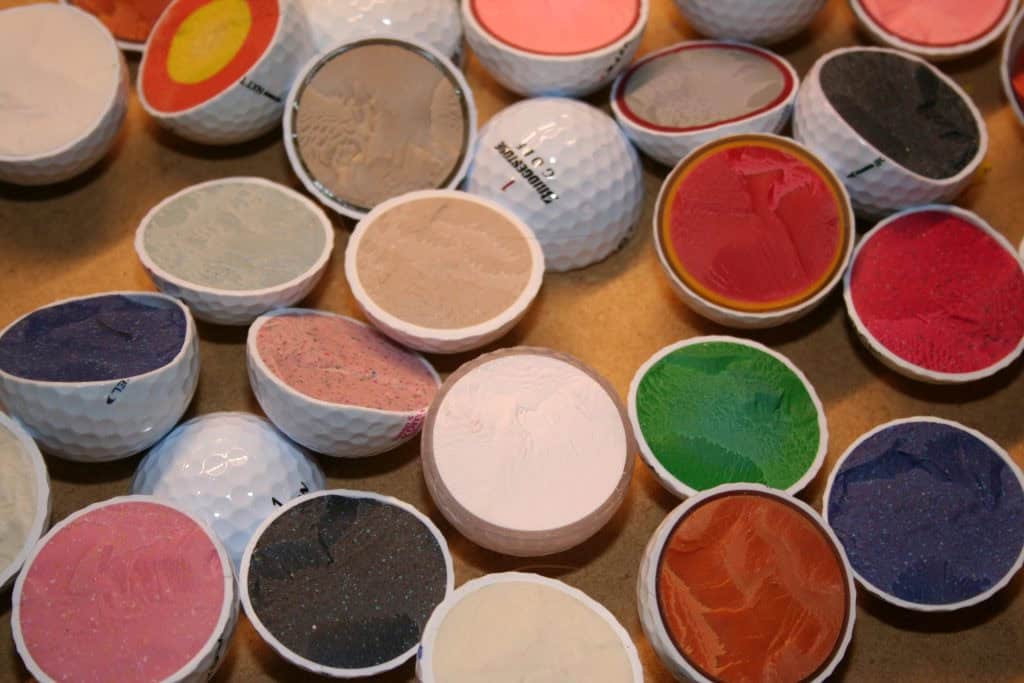Golf is a game that combines precision, skill, and a touch of science. While golfers focus on their swing and putt, have you ever wondered what goes on inside a golf ball? In this in-depth exploration, we’ll dissect the anatomy of a golf ball, from its core to its cover, revealing the secrets that make it soar through the greens.
The Core: The Heart of the Ball
Every golf ball has a core, and it’s not just any core; it’s the heartbeat of the ball. This small but essential component determines how the ball behaves in flight and on the ground.
The Different Types of Cores
Golf ball cores come in two primary types: two-piece and multi-piece.
Two-Piece Core:
- Known for its distance;
- Ideal for beginners;
- Comprises a solid rubber core.
Multi-Piece Core:
- Offers better control;
- Preferred by skilled golfers;
- Contains multiple layers with varying materials.
Pro Tip: The core’s composition significantly affects the ball’s performance. Manufacturers often adjust core materials for different playing conditions.
The Mantle: Bridging the Gap
Situated between the core and the cover, the mantle plays a vital role in controlling the ball’s spin and trajectory.
Mantle Variations
Golf ball manufacturers tweak the mantle’s properties to cater to various player preferences.
- Soft Mantle: Reduces driver spin for longer drives;
- Firm Mantle: Enhances control and spin around the greens;
- Dual Mantle: Combines the benefits of both soft and firm mantles.
Fun Fact: The mantle’s thickness and material can significantly impact the ball’s feel and playability.
The Cover: The Outer Shell
The outermost layer of a golf ball is its cover. The cover material influences both the feel and durability of the ball.
Types of Covers
Golf balls can have one of two types of covers:
- Surlyn Cover
-
- Known for its durability;
- Offers less spin;
- Preferred for distance.
- Urethane Cover
-
- Provides exceptional control and spin;
- Preferred by professional golfers;
- Ideal for approach shots.
Expert Tip: Selecting the right cover material is essential, as it impacts your game’s performance.
The Dimples: Aerodynamic Magic
Now, let’s dive into the intricacies of golf ball design. Those tiny dimples on the surface play a significant role in the ball’s flight.
Dimple Patterns
Manufacturers use various dimple patterns, such as:
- Spherical dimples;
- Hexagonal dimples;
- Octagonal dimples.
Each pattern is meticulously designed to optimize lift and reduce drag, allowing the ball to stay in the air longer and travel farther.
A Comparative Look
Let’s sum up the key differences between different golf ball components:
| Component | Two-Piece Core | Multi-Piece Core |
|---|---|---|
| Core Material | Solid rubber | Layered |
| Feel | Firm | Variable |
| Distance | Excellent | Good |
| Spin Control | Limited | High |
| Ideal For | Beginners | Skilled Players |
The Science Behind Golf Ball Flight
Ever wondered why golf balls fly the way they do? The answer lies in physics.
- Lift and Drag: Dimpled surfaces create turbulence that reduces drag and increases lift, allowing the ball to stay in the air;
- Backspin: Backspin generated by the dimples helps maintain stability during flight.

The Inner Workings of Golf Balls – A Closer Look
Exploring the Layers
Golf balls may appear simple on the outside, but they are marvels of engineering on the inside. Let’s dissect each layer and understand its significance.
The Outermost Layer: The Cover
The cover of a golf ball is the first point of contact with the clubface. Manufacturers often use either Surlyn or Urethane for this critical layer. Surlyn covers are known for their durability, making them suitable for beginners who may frequently mishit shots. On the other hand, Urethane covers provide excellent spin and control, making them a preferred choice for advanced players who prioritize precision over durability.
Beneath the Cover: The Mantle
Just beneath the cover, we find the mantle—a layer that’s often overlooked but plays a crucial role. The mantle helps control the ball’s spin and trajectory. Manufacturers experiment with mantle thickness and materials to fine-tune performance. A soft mantle reduces driver spin for longer distances, while a firm mantle enhances control for short shots and putting.
The Core: At the Heart of It All
The core is the innermost layer and the soul of a golf ball. It defines the ball’s compression and influences its feel and performance. Two-piece cores, typically made of solid rubber, are known for their distance. They are perfect for beginners and those seeking extra yardage off the tee. Multi-piece cores, on the other hand, consist of multiple layers with varying materials. They provide more control and are favored by skilled players who need to shape their shots.
Cracking the Dimple Code
Now, let’s delve deeper into the fascinating world of dimples. These tiny, often unnoticed features have a significant impact on a golf ball’s flight.
The Purpose of Dimples
Dimples create turbulence in the boundary layer of air around the ball, which reduces drag and enhances lift. This phenomenon allows the ball to stay airborne for a more extended period, resulting in greater distance. Think of dimples as the wings of a golf ball, keeping it aloft.
The Shape Matters
Manufacturers experiment with various dimple patterns, including spherical, hexagonal, and octagonal. The choice of dimple pattern can affect how the ball performs in different conditions. For instance, some patterns are optimized for maximum distance, while others prioritize control and spin.
The Magic of Numbers
The number of dimples on a golf ball varies from one model to another. There is no one-size-fits-all formula for the perfect number of dimples, as it depends on the ball’s design and intended performance. However, golf ball engineers meticulously calculate the number and arrangement to optimize aerodynamics.

Unleashing the Power of Golf Ball Technology
Innovations in Golf Ball Design
Golf ball technology is continually evolving, driven by a quest for better performance. Modern golf balls incorporate advanced materials and cutting-edge designs to help players of all skill levels improve their game.
High-Performance Cores
Manufacturers are pushing the boundaries of core technology. New materials and construction methods enable golfers to achieve impressive distances while maintaining control over their shots.
Multi-Layer Mastery
The multi-layered golf ball is now a standard choice for many players. With each layer serving a unique purpose, these balls offer versatility for various aspects of the game.
Alignment Aids
Some golf balls come with alignment aids—visual markings or lines—that help golfers line up their putts accurately. These markings are a valuable tool for improving putting consistency.
Customization Options
Today, golfers can customize their golf balls to match their playing style and preferences. This level of personalization was unheard of in the past.
Personalized Printing
You can now have your name, logo, or a personal message printed on your golf balls. It not only adds a unique touch but also makes it easier to identify your ball on the course.
Color Choices
Golf balls are no longer restricted to traditional white. Many players opt for high-visibility colors like yellow, orange, or even pink, making it easier to spot their ball in various lighting conditions.

The Future of Golf Balls
Environmental Concerns
With growing environmental awareness, manufacturers are exploring sustainable materials and production methods for golf balls. Biodegradable components and recycling initiatives are being considered to reduce the sport’s ecological footprint.
Advanced Analytics
As technology advances, golf balls may incorporate sensors and tracking devices, providing real-time data on spin rates, launch angles, and other vital statistics to help golfers fine-tune their game.
Smart Golf Balls
Imagine a golf ball that provides feedback on your swing and helps you select the right club for each shot. Smart golf balls with embedded sensors could revolutionize the way we approach the game.
The Art of Selecting the Right Golf Ball
Matching Your Game to the Ball
Choosing the right golf ball can significantly impact your performance on the course. It’s crucial to match the ball to your skill level, playing style, and the specific conditions you encounter during your rounds.
Here’s a simplified guide to help you select the ideal golf ball:
Beginners:
- If you’re new to the game, opt for a two-piece golf ball with a Surlyn cover;
- Look for a ball that promotes distance and forgiveness on mishits;
- Focus less on spin and more on getting comfortable with your swing.
Intermediate Players:
- Intermediate golfers can experiment with both two-piece and multi-piece balls;
- Consider your strengths and weaknesses; if you need more control, go for a multi-piece ball;
- Pay attention to the ball’s compression rating; a lower rating suits slower swing speeds, while a higher rating benefits faster swingers.
Advanced Players:
- Advanced golfers should explore multi-piece balls with Urethane covers;
- Prioritize feel and spin control, especially around the greens;
- Fine-tune your ball selection to suit your playing style; if you prefer a soft feel, opt for a ball with a soft mantle.
Understanding Compression
Golf ball compression is a crucial factor that affects the ball’s performance. Compression rating typically falls within the range of 70 to 110. Here’s a breakdown of how compression relates to swing speed:
Low Compression (70-80):
- Best for slower swing speeds (less than 85 mph);
- Offers more distance for golfers with less clubhead speed;
- Provides a softer feel.
Mid Compression (85-95):
- Suits a wide range of swing speeds (85-105 mph);
- Balances distance and control;
- Provides versatility for a broad spectrum of players.
High Compression (100+):
- Designed for faster swing speeds (above 105 mph);
- Offers exceptional control and spin;
- Requires a skilled golfer to maximize its benefits.
Budget-Friendly Options
Golf balls come in various price ranges, from budget-friendly to premium. Here are some options for golfers looking to save some green:
Recycled Golf Balls:
- These are used golf balls that have been cleaned and restored;
- A cost-effective choice for practice rounds or beginners.
Value Packs:
- Many manufacturers offer value packs with multiple balls at a reduced per-ball cost;
- Great for golfers who go through several balls during a round.
Off-Brand Balls:
- Some lesser-known brands produce quality golf balls at more affordable prices;
- Don’t be afraid to explore these options if you’re on a tight budget.

Mastering the Art of Golf Ball Care
Cleaning Your Golf Balls
Keeping your golf balls clean is essential for maintaining their performance. Dirty balls can affect their trajectory and distance. Here’s how to clean your golf balls effectively:
- Warm Soapy Water: Fill a bucket or sink with warm, soapy water;
- Soak: Place your golf balls in the soapy water and let them soak for a few minutes;
- Scrub: Use a soft brush or cloth to gently scrub each ball, removing dirt and debris;
- Rinse: Rinse the balls thoroughly with clean water to remove any soap residue;
- Dry: Allow the golf balls to air dry or use a clean towel to pat them dry.
Storage Tips
Properly storing your golf balls ensures they remain in top condition:
- Cool, Dry Place: Store your golf balls in a cool, dry place to prevent heat and humidity from affecting their performance;
- Ventilated Container: Consider using a mesh bag or container that allows air circulation;
- Avoid Extreme Temperatures: Don’t expose your golf balls to extreme temperatures, such as leaving them in a hot car.
Inspect for Damage
Regularly inspect your golf balls for any signs of damage, including cracks or cuts. Damaged balls can behave unpredictably and should be replaced. It’s also a good idea to mark your golf balls with a unique identifier to avoid confusion with playing partners.
The Science of Spin: Mastering Your Short Game
Backspin vs. Sidespin
Understanding spin is crucial, especially when it comes to approach shots and putting. Here’s a breakdown of the two primary types of spin in golf:
Backspin:
- Backspin occurs when the clubface imparts vertical spin on the ball;
- It causes the ball to climb and creates lift, leading to longer and higher shots;
- Backspin is essential for holding the green on approach shots.
Sidespin:
- Sidespin happens when the clubface imparts horizontal spin on the ball;
- It causes the ball to curve left or right in flight;
- Sidespin can be controlled for shaping shots around obstacles.
Techniques for Spin Control
Controlling spin on your golf shots requires skill and practice. Here are some techniques to help you master spin:
- Ball Position: Adjust your ball position in your stance to control the angle of attack and spin;
- Club Selection: Choose the right club for the desired trajectory and spin;
- Clean Clubface: Ensure your clubface is clean for better contact with the ball;
- Groove Maintenance: Regularly clean and maintain the grooves on your irons for optimal spin control;
- Practice: Spend time on the practice range honing your ability to control spin on approach shots and chips.
Conclusion
Understanding the inner workings of a golf ball is essential for golfers looking to improve their game. From the core to the cover, each component plays a vital role in determining how the ball performs on the course. Choosing the right golf ball that suits your playing style can make a significant difference in your game.
FAQs
Dimples on golf balls create turbulence, reducing drag, and increasing lift, which helps the ball stay in the air longer.
Two-piece cores are solid rubber and offer distance, while multi-piece cores have layered materials for better control.
Surlyn covers are durable and ideal for beginners due to their distance-enhancing properties.
Professional golfers often prefer soft mantles for better control and spin around the greens.
Consider your playing style and skill level when selecting a golf ball. Consult with a golf pro for personalized recommendations.
